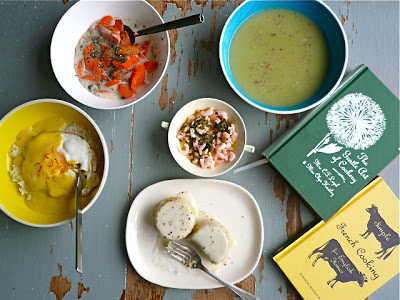@font-face {
font-family: “?? ??”;
}@font-face {
font-family: “?? ??”;
}@font-face {
font-family: “Cambria”;
}p.MsoNormal, li.MsoNormal, div.MsoNormal { margin: 0cm 0cm 0.0001pt; font-size: 12pt; font-family: Cambria; }.MsoChpDefault { font-family: Cambria; }div.WordSection1 { page: WordSection1; }
Classic Voices in Food
It’s a series of unabridged cookbooks by Quadrille which brings back to life the fascinating culinary outlook of a bygone era. Both books reviewed here, Simple French Cooking and The Gentle Art of Cookery, were first released just after the first world war. Both of them revived, changed people’s attitude towards food and the art of culinary between the wars, showing it is possible to eat good simple fare in light of adversity. These printed works were edited by Jill Norman, who is the literary trustee of the Elizabeth David estate, and worked with Mrs David for years. I was sent these books by Quadrille to be reviewed.
 |
| carrots au Bechamel, lettuce soup, prawns au Maitre D’Hotel sauce, whitting creams, eggs frits au safran |
Simple French cooking for English Homes by X. Marcel Boulestin
First published in 1923
Xavier Marcel Boulestin (1878-1943) started his working life writing for the theatre, then moving on to be secretary of a humorous writer in Paris. Later in 1906 he moved to London where he translated books, started a successful interior design business and became enchanted by all things English. Boulestin started cooking for himself and for people’s dinner parties, after the first World war when is interior design business failed to take off again . He became a food writer after a chance meeting with a director of publisher Heinemann, a UK publishing house founded in 1890, with whom he was negotiating the sale of some etchings. His first book was released in 1923 and it was a immediate success. This particular book is aimed to introduce excellence , simplicity at low cost to a post war English home. Boulestin was responsible for the good food revival after the WWI and popularise French cuisine in the English-speaking world . He opened a restaurant in London called simply Restaurant Francais, which started in Leicester Square after moving to Southampton Street in Covent Garden when it changed it’s name to Boulestin. The restaurant was his great achievement. It survived under different owners till the early 90’s.
Boulestin was the first live TV chef on the BBC in 1937. He made 15 minutes television programs entitled “Cook’s Nigh Out’ . Boulestin followed his success by teaching cookery, writing books and articles were the inspiration and influence on Elizabeth David’s work after the second world war.
This book contains 114 pages, crammed with simple recipes. There’s a conversion chart at the beginning . The first chapter is a series of general and special remarks. Cleverly written some of them are old fashioned and others are very amusing. The recipes are divided into soups, sauces, egg dishes, fish, meat, vegetables, salads, sweets and pastry and sundries. The last small chapter are remarks about wine. Mainly how to shop, store and serve wine.
There is a chapter that helps you devise a week’s menu and late suppers.
 |
| eggs frits au safran |
The Gentle Art of Cookering
Mrs C.J.Leyel and Miss Olga Hartley
First published in the early-mid 1920’s by Hilda Leyel, this book is based on her menus served to their friends, ingredients available all year round and in alphabetical order. The idea behind this book is that you buy the ingredients first and decide the menu later. For the first time vegetable and fruit were depicted in detail in a cookbook and their chapters supply a wide range of cooking methods. The author encourages to consumption of small amount of meat. There’s a children’s chapter which encourages them to get involved in cooking. Mrs Leyel studied herbalism and spices. A good understating of the Eastern, African and Mediterranean cuisine is shown by a presence of some exotic recipes.
This book was designed with the home cook in mind. It varies from casual to more detailed description of the dishes. Exciting and creative, this hardcover book contains 750 recipes spread over 413 pages. The book is divided in twenty chapters : sauces, vegetables, chestnuts, mushrooms, fish, eggs, meat, cold supper dishes, dishes from the Arabian nights, rice and cereals, poultry and game, fruits, almonds, creams, custards and jellies, sandwiches and savouries, homemade wines and cups, cooking for children, flower recipes, cakes and alchemist’s cupboard.
I tried a few recipes from both books and they worked beautifully. They are not for beginners but at the same time they don’t contain overly complicated recipes. There are no photos or drawings. Measurements and weights are not always clearly stated. The reason is because these books were kept exactly as originally published. Recipe writing has come a long way since the 1920’s. However, if you have some experience in the kitchen you will be able to follow the recipes and instinctively make the recipe up as you go along.
These printed works were designed for the passionate and thrifty home cook. I made a point to use all ingredients I had at home, no shopping involved. I can’t think of a better time to re-release these books due to the recent world economy downturn. These books are real classics and a must for the food lovers. They will be release on the 5th September (tomorrow).
Other books in the series: Modern Cookery for Private Families and Madame Prunier’s Fish Cookery Book.





Have been thinking about buying both these so I'm glad to see a good review. I have Madame Prunier's Fish Cookery Book (yet to publish my review, oopps) which I'm finding interesting – a good read.
Nice photos too : 0
I have had this experience as well using old recipes – measurements are quite vague and they presume a lot more experience than modern cook books. Still it all adds to the adventure!
Hello Ailbhe, they look great and they are very nicely bounded. I am looking forward to read your review on Madame Prunier's book too.
Jonny – you are so lovely and sooo supportive! Very proud of your progress in the kitchen too.
Hi Cara, I really enjoyed reading the old recipes. It's true it all adds to the fun.
My cookbook addiction is getting a little out of control- but I think these would make gorgeous additions… Add another couple to the shopping list!
Hi Tori – I know what you mean! There are some many lovely books out there
We can easily get carried away….